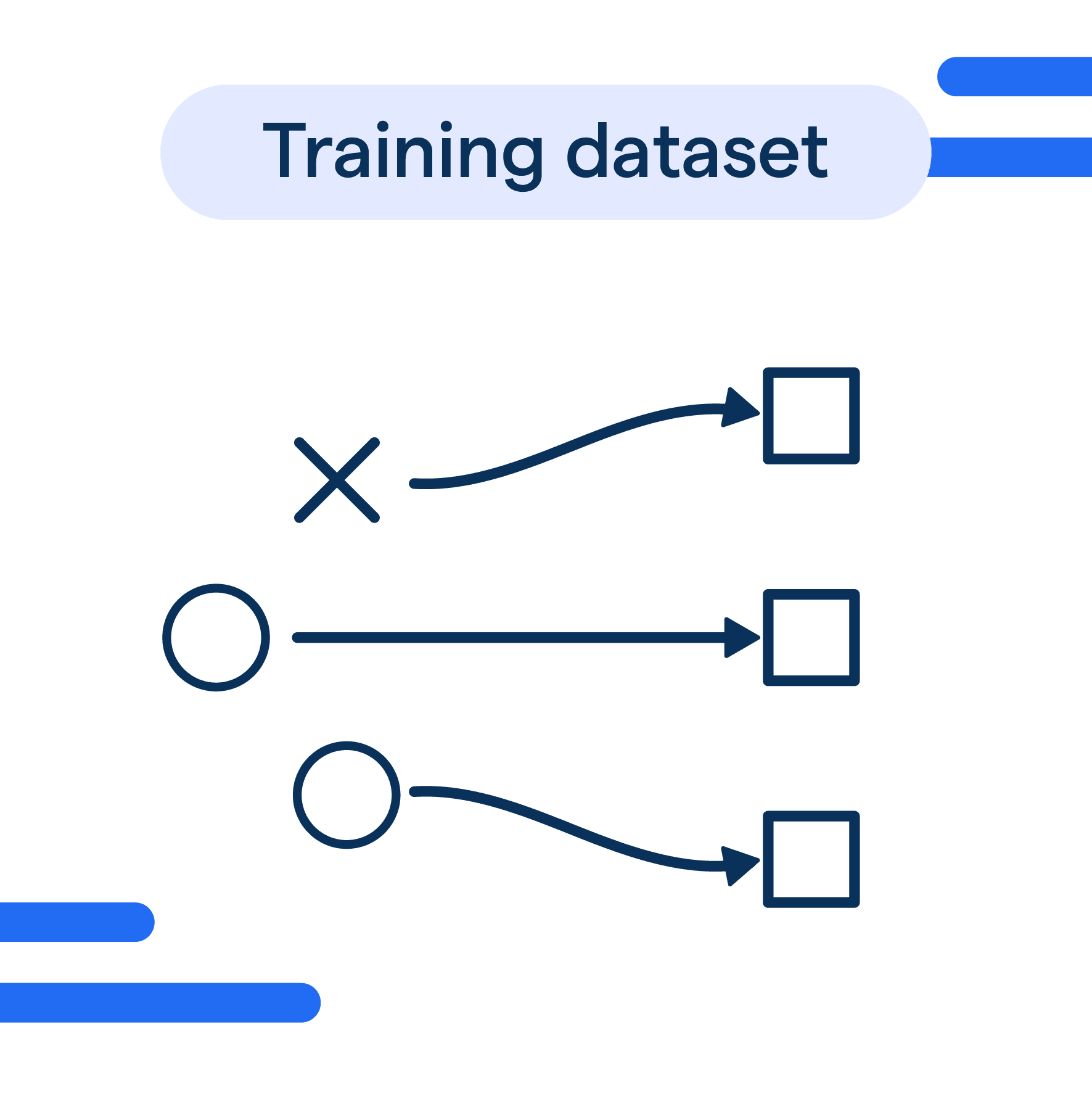What is a Training Dataset?
A training dataset is a collection of examples or observations used to train a machine learning model. It consists of input data (features) and corresponding output labels. The purpose of a training dataset is to enable the model to learn patterns and make accurate predictions or classifications on new, unseen data.
Why is a Training Dataset Important?
Foundational Role in Machine Learning
Training datasets lay the base for machine learning models. They provide the initial set of data through which an algorithm can 'learn' and understand how to apply its learnings to unknown data.
Enhancing Accuracy and Precision
Training datasets play a crucial role in enhancing the accuracy and precision of AI algorithms. The better the quality of the training dataset, the better the AI can perform, making accurate and reliable predictions.
Teaching the Algorithm
A training dataset essentially acts as an instructor for the machine learning model. It presents the algorithm with inputs and desired outputs, teaching it to create its own correct responses when new, similar data is encountered.
Variability and Representation
Training datasets need to be representative and diverse, including wide variations of data to ensure a well-rounded 'learning' experience for the machine. This variety helps to build an algorithm capable of handling a multitude of scenarios.
Model Evaluation and Improvement
Finally, training datasets play a significant role in evaluating and improving models. By comparing the model's outputs to the actual data in the training set, developers can refine the model to improve its performance. These datasets thus influence the entire lifecycle of model development.
Who Creates Training Datasets?
The creation of training datasets is a core pillar in developing effective machine learning models. Let's examine who takes on the responsibility of crafting these crucial resources.
Data Scientists
Data scientists often create training datasets as part of their role in building and refining machine learning models.
AI Engineers
AI engineers develop algorithms applicable to training datasets and may also be involved in their creation to ensure these datasets meet the algorithm's requirements.
Data Labeling Services
Specialized data labeling services often curate training datasets. These can range from companies like Appen and Amazon's SageMaker to crowdsourcing platforms like Mechanical Turk.
Research Institutions
Academic and research institutions often create training datasets to facilitate research in diverse fields such as computer vision, natural language processing, and more.
Open Source Contributors
Often collaborative, open-source datasets are put together by individuals or groups contributing to the advancement of AI and Machine Learning research globally.
How to Create a Training Dataset?
Let's explore the steps on how to create a top-quality training dataset that paves the way for accurate machine learning models.
Define the Problem
The first step in creating a training dataset is to define the problem you want your model to solve. It helps you determine the type of data you need.
Data Collection
Gather the raw data that is relevant to your problem. Data sources can vary widely from text files, images, sensor data, and more.
Preprocessing of Data
Data cleanup and preprocessing is key to quality training datasets. It includes removing irrelevant data, handling missing data and outliers, and normalizing data.
Data Labeling
Labeling involves classifying data into categories your algorithm will predict. In image recognition, for example, labeling can involve marking and categorizing different objects within images.
Split Your Data
Finally, divide your data into two sets: the training set used to train your model, and a testing set used to verify the accuracy of your model.
Remember, a quality dataset is the backbone of any successful machine learning model.
Types of Training Datasets
Dive into the world of machine learning and data science to understand why training datasets are the backbone of successful AI implementations.
Foundational Role in Machine Learning
Training datasets lay the base for machine learning models. They provide the initial set of data through which an algorithm can 'learn' and understand how to apply its learnings to unknown data.
Enhancing Accuracy and Precision
Training datasets play a crucial role in enhancing the accuracy and precision of AI algorithms. The better the quality of the training dataset, the better the AI can perform, making accurate and reliable predictions.
Teaching the Algorithm
A training dataset essentially acts as an instructor for the machine learning model. It presents the algorithm with inputs and desired outputs, teaching it to create its own correct responses when new, similar data is encountered.
Variability and Representation
Training datasets need to be representative and diverse, including wide variations of data to ensure a well-rounded 'learning' experience for the machine. This variety helps to build an algorithm capable of handling a multitude of scenarios.
Model Evaluation and Improvement
Finally, training datasets play a significant role in evaluating and improving models. By comparing the model's outputs to the actual data in the training set, developers can refine the model to improve its performance. These datasets thus influence the entire lifecycle of model development.
Data Labeling in Training Datasets
Data labeling plays a crucial role in the development of machine learning models, allowing them to accurately interpret and respond to new inputs. Let's go through what makes it so indispensable.
Ground Truth Generation
Data labeling helps create a 'ground truth' from which the machine learning model can learn and make its predictions accurately.
Supervised Learning Preparation
For supervised learning, data labeling is essential as it provides the model with both the input data and the corresponding correct output.
Quality of Your Predictive Models
The quality of data labeling directly impacts the effectiveness and accuracy of your predictive models, with poorly labeled data potentially leading to less accurate predictions.
Time and Cost
Data labeling can be a time-consuming and costly process particularly for large datasets, which often requires human intervention or the use of automated data labeling tools.
Ethical Considerations
There are ethical considerations in data labeling, particularly regarding user privacy and avoiding bias, which can impact the fairness and effectiveness of the machine learning model.
Evaluating the Quality of a Training Dataset
Evaluating the quality of a training dataset is essential to ensuring the effectiveness of any machine learning model. Here are some key factors to consider when assessing a dataset's quality.
Data Completeness
Ensure that the dataset contains all relevant features and variables necessary for the chosen machine learning model or task.
Data Accuracy
Verify that the data is accurate, error-free, and correctly labeled, as inaccuracies can lead to poorly performing models.
Balanced Classes
Check for class balance to avoid any biases within the dataset. Imbalanced data often results in biased predictions and decreased model accuracy.
Representativeness
Evaluate if the dataset accurately represents the problem space, encompassing the diverse range of inputs the model will likely encounter.
Data Consistency
Examine the dataset for uniformity, ensuring that data points are consistent in terms of units, measurements, and data types.
Frequently Asked Questions (FAQs)

What is a Training Dataset?
A Training Dataset is a set of data used to train or build machine learning models. It's used to teach an algorithm how to recognize patterns in data and make predictions.
What types of data can be included in a Training Dataset?
Training Dataset can include text, images, audio files, or any other type of data that the machine learning model needs to learn from.
How is a Training Dataset different from a Testing Dataset?
A Training Dataset is used to train a machine learning model, whereas a Testing Dataset is used to evaluate the performance of the model. A model that performs well on the Training Dataset may not necessarily perform well on the Testing Dataset.
How do I create a Training Dataset?
To create a Training Dataset, you need to collect and annotate a large set of data related to the problem you are trying to solve. Depending on the type of data, you may need to use different tools to annotate the data.
Why is having a good Training Dataset important for machine learning?
A good Training Dataset is critical for machine learning because it allows the algorithm to learn from a wide variety of examples, making it more accurate and robust. Without a good dataset, the machine learning model may not perform as expected.

